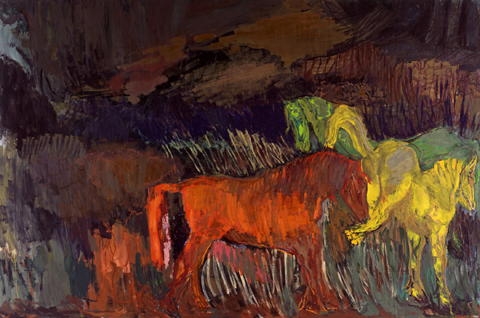
'UNTITLED,' 2009, tempura on canvas. [Courtesy Michael Werner Gallery, New York and Berlin.] |
The current show by the highly-acclaimed Danish artist Per Kirkeby at the Bowdoin College Museum of Art is a broad survey of his work, with examples of his paintings and sculpture from the 1960s up to a few years ago. The exhibition was organized at the Phillips Collection in Washington, D.C., where it appeared last year. It provides a broad view of the intellectual and poetic range of this truly significant artist.
There is a philosophical consideration in physics called the anthropic principle that states that the way we understand the parameters of the universe is in fact the only way we, as humans, are constitutionally equipped to comprehend it, given the limitations of our consciousness. The great physicist Richard Feynman cautioned that our awareness of nature was not nature itself, but a human model of it.
Kirkeby is an artist, poet, essayist, filmmaker, and novelist, but his earliest training was as a scientist, a geologist. He did field work in the Arctic, including in northern Greenland, and his sense of the chaotic order of geological ebb and flow permeates this whole body of work. What makes it interesting is not simple mimetic imagery, but the presence of an overarching body of ideas that display his insight into the subjective nature of human experience. Art, or language, or philosophy, and even science become not so much an expression of the world as it exists, or even as we see it, but as a construct we can build, revealing both the limitations of our ability to directly know what is real and the sometimes arbitrary conceptual order that we impose on nature.
The earliest paintings in this show, from the mid-1960s, reveal an admixture of folk art with Pop ironies and fractured geological imagery combined in the service of an implied narrative. In 'Regicide at Finderup Barn' (1967), the silhouetted figure of a warrior with axe stands above a snow-laden log dwelling, while outlines of a large bird and a building, perhaps a cathedral or palace, drift unmoored on the surface. There is a story to be inferred here, historical or perhaps legendary, but it is firmly positioned in the art-historical and philosophical context of the period when the piece was made.
The essay in the accompanying catalog cites a number of influences on Kirkeby's thinking, from which I choose three: Paul Cèzanne, Ludwig Wittgenstein, and George Maciunas. Kirkeby understands, as perhaps only an artist can, that Cèzanne went to great trouble over years of work to produce a method that posited a truth about his experience. The radical nature of his results were more a matter of personal imperative than of theory.
In the catalog essay, exhibition curator Klaus Ottmann says that Kirkeby was under the spell of Wittgenstein, especially his assertion that "thoughts and propositions are pictures: 'The picture is a model of reality.' "